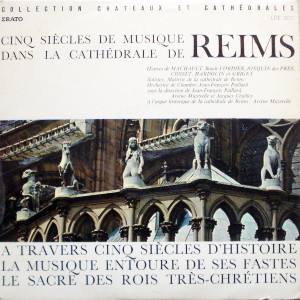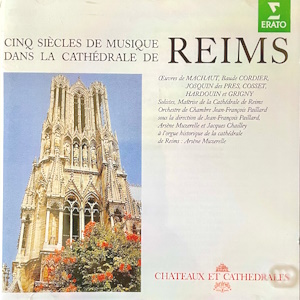 |
|
1 LP -
STE 50 277
|
 |
| 1 CD -
3984 20985-2 |
|
| CINQ SIÈCLE DE MUSIQUE DANS LA
CATHÉDRALE DE - REIMS |
|
|
|
|
|
| A TRAVERS CINQ SIÈCLES D'HISTOIRE
LA MUSIQUE ENTOURE DE SES FASTES LE SACRE
DES ROIS TRÈS-CHRÉTIENS |
|
|
|
|
|
| Josquin des Prés
(c.1450-1521) |
1. Fanfares
royales pour le sacre de Louis XII
(1498): "Vive le Roy" |
1' 04" |
A1
|
| Guillaume de Machaut
(entre 1300 et 1305 - 1377) |
2.
Motet "Felix Virgo"
(Transcription: J. Chailley) *
|
5' 24" |
A2
|
| Baude Cordier
(début du XV siècle) |
3. Gloria
pour trois voix mixtes et cuivres |
3' 29" |
A3
|
| François Cosset
(vers 1620 - après 1682) |
4. Missa quatuor
vocum "Cantate Domino" |
13' 32" |
A4
|
|
- Kyrie · Gloria · Sanctus ·
Benedictus · Agnus Dei |
|
|
| Henri Hardouin
(727-1808) |
5.
Magnificat (Motet à cinq voix
st Symphonie) |
18' 06" |
B1
|
|
-
Magnificat: Récit gracieux |
|
|
|
-
Et exultavit: Récit et chœur |
|
|
|
- Quit respexit: Récit
tendre et gracieux |
|
|
|
-
Fecit potentiam: Chœur en faux
bourdon |
|
|
|
-
Deposuit potentes: Duo léger |
|
|
|
-
Suscepit Israel: Récit gracieux |
|
|
|
-
Gloria Patri: Chœur gracieux et
lent |
|
|
| Nicolas de Grigny
(1672-1703) |
6.
Hymne "Veni Creator" en
Taille à 5 |
12' 01" |
B2
|
|
-
a) en taille à 5 Récit de Cromorne ·
Dialogue sur les Grand Jeux |
|
|
|
-
b) Fugue à 5 |
|
|
|
-
c) Récit de Cromorne |
|
|
|
-
d) Dialogue sur les Grand Jeux |
|
|
|
|
|
LE
TROMBENES DE L'ORCHESTRE DE LA
R.T.F. (1)
|
André Mallabrera,
Ténor (5) |
|
| Jean
François Paillard, Direction (1) |
Rémy Corazza,
Ténor (5) |
|
|
Roger Soyer,
Basse (5) |
|
Rémy Corazza, Ténor
(2)
|
LA MAÎTRISE DE LA CATHÉDRALE DE REIMS (5) |
|
| José
van Dam, Basse (2) |
ORCHESTRE
JEAN-FRANÇOIS PAILLARD (5) |
|
| Jacques
Chailley, Direction (2) |
Jean
François Paillard, Direction (5) |
|
|
|
|
| LES
ALOUTTES DE CHAMPAGNE (1,2,3) |
Arsène
Muzerelle, à l'orgue Gonzales
(6) |
|
| Arsène
Muzerelle, Direction (3) |
|
|
|
|
|
| LA MAÎTRISE DE LA CATHÉDRALE DE REIMS
(4,5) |
|
|
| Arsène
Muzerelle, Direction (4) |
|
|
|
|
|
|
Luogo
e data di registrazione |
|
Cathédrale
de Reims (France) - 1965
Eglise Saint-Roch, Paris (France -
1965 *
|
|
|
Registrazione:
live / studio |
|
studio |
|
|
Engineer |
|
Peter
Willemoës
|
|
|
Edizione LP |
|
Erato
- STE 50 277 - (1 lp) - durata 43'
53" - (p) 1965 - Analogico |
|
|
Edizione CD |
|
Erato
- 3984 20985-2 - (1 cd) - durata
43' 53" - (c) 1987 - Analogico |
|
|
Note |
|
Details
from Musical Heritage Society MHS
894
|
|
|
|
|
En
baptisant Clovis
roi des Francs en
l'an 496, Saint
Rémy préluda à la
longue tradition
des sacres qui,
hormis les
premiers, se
dérouòèrent à la
Cathédrale de
Reims durant
plusieurs siècles.
L2
6 mai 1211,
l'Archevêque
Aubry de Humbert
posa la première
pierre de
l'édifice
actuel, à
l'emplacement
même
de deux
églises qui
s'étaient
succédèes
depuis le
cinquième
siècle. Cette
nouvelle
cathédrale,
conçu selon de
vastes
proportions
pour abriter
les plus
grandes
cérémonies du
royaume, fut
construitè
dans un grand
élan mystique.
Les travaux se
poursuivirent
durant òe
13eme et 14eme
siècle, mais
dès 1241, le
transept et le
chœur
étaient
achevés et ie
Chapitre put
s'y installer.
Cette
métropole
religieuse
devint
rapidement un
lieu culturel
et artistique
important.
Architectes,
sculpteurs,
mais aussi
poètes,
musiciens se
groupèrent
autour de la
cathédrale.
Les recherches
entreprises à
Reims par MM.
l'Abbé Cerf,
le Chanoine
Leflon, l'Abbé
Hesse entre
autres,
témoignent de
la vitalité et
de la richesse
de ce foyer
musical.
Certains de
ces
compositeurs
n'eurent
qu'une
activité
locale;
d'autres
séjournèrent à
Reims avant de
gagner la
capitale;
d'autres
enfin, comme
Guillaume de
Machault,
Nicolas de
Grigny, eurent
une
personnalité
musicale telle
que leur renom
s'étendit
rapidement au
déjà de nos
frontières.
The
"Fanfare royale”
which opens this
program is not by a
native musician of
Reims. It was,
however, for the
occasion of the
coronation of Louis
XII that this "Vive
le Roy” by JOSQUIN
DES PRES was
performed in the
Cathedral.
The beautiful motet,
Felix Virgo,
is one of the most
perfect
examples of a great
motet of the Ars
Nova, which returns
to and
enlarges upon the
isorhythmic
technique of the
preceding epoch.
As usual with this
type of composition,
two independent
melodies
with different texts
are set against each
other over an
instrumental
tenor which
determines the
character of the
piece. It is
completed,
in the background,
by an equally
instrumental
counter-tenor part
(an innovation of
the fourteenth
century). Basis and
point of
departure of the
composition, this
particular tenor is
an excerpt of
the Salve Regina
(solemn tone), from
Ad te suspiramus
up to and
including advocata
nostra. After
an opening section
omitting the
theme, the cantus
firmus is presented
first in long-held
notes divided
by rests, following
a complex rhythmic
plan (thirty-five
measures
in rhythm, repeated
three times) in
which the
counter-tenor also
participates. The
isorhythm, by
contrast, hardly
affects the vocal
parts except in a
very approximate
way, but these are
not any less
elaborate
melodically, with a
frequent exchange of
thematic motifs
circulating between
one voice and the
other. Finally, a
closing
section in the
nature of a
brilliant coda,
wherein syncopations
and
"hockets” abound in
the vocal parts,
leading to the final
Cum
gaudio, takes
up again the cantus
firmus in the tenor
with the
note-values reduced
exactly by half,
which introduces
interesting
rhythmic
combinations and
contributes a truly
remarkable aspect
of dynamic motion to
the composition a£ a
whole.
JACQUES
CHAILLEY
We
have but little
information about
BAUDE CORDIER, this
poet-musician of the
early fifteenth
century. One
manuscript, now
in the Condé Museum
in Chantilly,
informs us, however,
that the
author:"Master
Baude Cordier, by
name. From Reims,
whose music as far
as Rome,
Is heard far and
wide.”
From
his essential
secular output, only
one sacred piece has
reached
us, a Gloria
in three parts.
Dating from past the
Ars Nova, the
melodic shape and
the rhythm of this
piece already
suggest the
style of Dufay.
FRANÇOIS COSSET was
born around 1620 in
Saint Quentin or
its environs. He
obtained a modest
post as chorister at
Laon, settled
for a time at
Senlis, and then
lived from 1643 to
1646 in Paris,
where he occupied
the position of
Director of Music at
Notre
Dame. In 1647 he was
named Musical
Director of the
Cathedral
at Reims. He filled
that post until 1662
and died around
1682. A
large part of his
sacred work was
published in Paris
by Ballard.
His Missa
quatuor vocum ad
imitationem moduli
"Cantate Domino”
is unique in its a
cappella setting.
Although it dates
from the
middle of the
seventeenth century,
it is written in the
tradition of
the old Renaissance
masters and
demonstrates such
learning and
contrapuntal
refinement that only
the most highly
trained choirs
could perform it.
One cannot determine
precisely the date
of the founding of
"la Maitrise”
(musical
establishment) at
Reims. Certain
historians
trace it back as far
as Charlemagne; but
this much is
certain, that
from the beginning
of the fourteenth
century the archives
offer
proof of the
existence of a
children’s choir.
The Maitrise was
established around
the period of the
Renaissance and
became one
of the most
important in France.
One of the virtues
of such institutions
was that musical
traditions could be
transmitted from
generation to
generation and
thereby develop
singers, composers
and
organists, of which
Hardouin is one of
the most illustrious
representatives.
HENRI HARDOUIN was
born at Grandpré in
the Argonne region
in 1727. At the age
of eight he entered
the Maitrise. At the
end
of his years in
service there
Hardouin was
ordained as priest
and
obtained the post of
Musical Director of
the Chapter at
Reims.
After the Revolution
he retired to
Grandpré where he
died on
August 13, 1808. The
manuscripts of
Hardouin that could
be
salvaged during the
war of 1914-1918 are
in the Maitrise at
Reims.
The Magnificat
recorded here is a
brilliant work
intended for
a grand ceremony.
Around a five-part
choir, the composer
has
grouped three
soloists, a string
quartet, two horns,
one bassoon,
two clarinets, and
one flute. Written
in the style of the
French
motets of the
seventeenth century,
it is divided into
seven verses,
the text of which is
made meaningful and
is illustrated
through the
variety of writing,
rhythm, and the
choice of voices or
instruments.
The origins of an
organ in the
Cathedral go back a
great
distance in time.
Without doubt, there
was one in existence
during
the twelfth century.
Still, in 1468,
Etienne Hénoque
began to
construct an
instrument in the
north transept that
was destroyed
by fire shortly
thereafter. The
Chapter then decided
to build a new
organ, a task
entrusted to a
builder of real
talent, Oudin
Hestre.
Several new features
were added in the
course of the
following
centuries, but by
the time of Grigny
it was considered
one of the
most significant and
most beautiful
organs in all of
France. Son
and grandson of
Reims musicians,
Nicolas de Grigny
left the
province at an early
age to study the
organ in Paris under
the
direction of Nicolas
Lebègue. He was
organist at
Saint-Denis from
1693 to 1695, but
after his marriage
he returned to
settle in
Reims where he was
named organist at
Notre Dame. His only
Livre d’Orgue
was published in
1699. Four years
later Grigny
died at the age of
thirty-one years.
The Hymn Veni
Creator
consists of five
verses. In the
first, the
piain chant theme,
stated by the reed
stops, appears in
long notevalues in
the tenor, supported
on the manual by
full organ. A
five-voiced fugue
follows where, in
elegant and learned
polyphony,
there are entwined
in supple arabesque
two parts on the
cromorne
and two on the
cornet, after which
the fifth voice
appears in the
pedal on 8' and 4'
principals. The
third movement, a Duo,
is
omitted in this
recording. The
following verse is a
charming
Récit de cromorne
accompanied in echo
by the quintaton and
the
4' viol. Finally,
the Dialogue sur
les grands
jeux is an
elaborate
large-scale piece in
three sections: two
parts, grave and
majestic,
calling for the
tutti on the full
organ, frame a
lively and rhythmic
third part, in which
the plein-jeu
of the Great and
that of the
Positive answer
eaefi other.
After the first
World War the organ
and the Maitrise at
Reims
were silenced for
many years. But, in
1927, Cardinal Luçon
revived the
Maitrise, entrusting
the direction to
Canon Hesse, who
in turn gave it over
in 1960 to one of
his former
choristers, Arsène
Muzerelle. It wasn’t
until 1938 that the
organ, badly damaged
through bombardment,
underwent complete
restoration by the
organ-builder,
Victor Gonzalez.
Today, the Church
that witnessed
coronations has
recovered its former
splendor, and the
children who
set out for the
Cathedral to sing in
the services each
Sunday might
wonder whether they
are reviving a past
which, without them,
would perhaps be
doomed to be
forgotten and, in
this way, they
render the most
beautiful homage to
the old masters of
their city.
NICOLE WILD
(Translated
from the French
by Alice Levine
Mitchell)
|
|